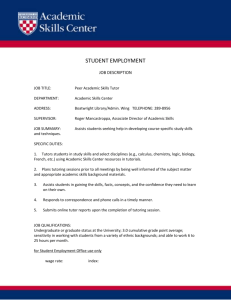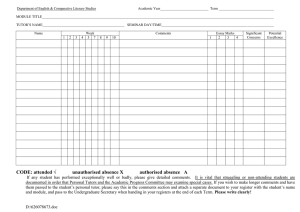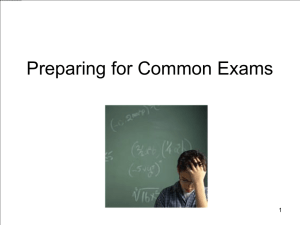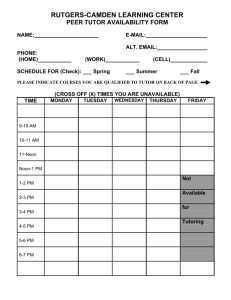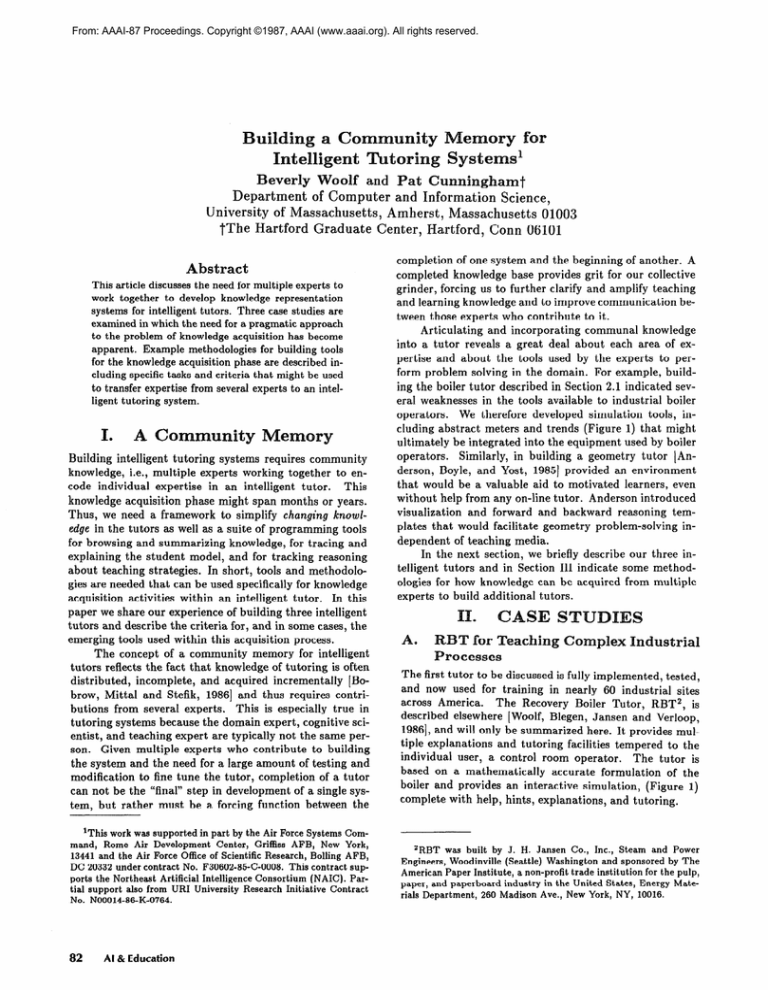
From: AAAI-87 Proceedings. Copyright ©1987, AAAI (www.aaai.org). All rights reserved.
Building a Common
Intelligent
Beverlly Woolf and Pat Cunninghamt
Department of Computer and Information Science,
University of Massachusetts, Amherst, Massachusetts 01003
tThe Hartford Graduate Center, Hartford, Conn 06101
Abstract
This article discusses the need for multiple experts to
work together to develop knowledge representation
systems for intelligent tutors. Three case studies are
examined in which the need for a pragmatic approach
to the problem of knowledge acquisition has become
apparent. Example methodologies for building tools
for the knowledge acquisition phase are described including specific tasks and criteria that might be used
to transfer expertise from several experts to an intelligent tutoring system.
completion of one system and the beginning of another. A
completed knowledge base provides grit for our collective
grinder, forcing us to further clarify and amplify teaching
and learning knowledge and to improve communication between those experts who contribute to it.
Articulating and incorporating communal knowledge
into a tutor reveals a great deal about each area of expertise
and about
operators.
I.
A Community
Memory
Building intelligent tutoring systems requires community
knowledge, i.e., multiple experts working together to encode individual expertise in an intelligent tutor.
This
knowledge acquisition phase might span months or years.
Thus, we need a framework to simplify changing knowledge in the tutors as well as a suite of programming tools
for browsing and summarizing knowledge, for tracing and
explaining the student model, and for tracking reasoning
about teaching strategies. In short, tools and methodologies are needed that can be used specifically for knowledge
acquisition activities within an intelligent tutor. In this
paper we share our experience
of building
reflects
the fact that knowledge
of tutoring
is often
distributed, incomplete, and acquired incrementally [Bobrow, Mittal and Stefik, 19861 and thus requires contributions from several experts.
This is especially true in
tutoring systems because the domain expert, cognitive scientist, and teaching expert are typically not the same person.
Given multiple experts who contribute to building
the system and the need for a large amount of testing and
modification
to fine tune the tutor,
completion
of a tutor
can not be the “final” step in development of a single sys-
tem, but rather must be a forcing function between the
lThis work was supp orted in part,by the Air Force Systems Command, Rome Air Development Center, Griffiss AFB, New York,
13441 and the Air Force Office of Scientific Research, Bolling AFB,
DC 20332 under contract No. F30602-85-C-0008. This contract supports the Northeast Artificial Intelligence Consortium (NAIC). Partial support also from URI University Research Initiative Contract
No. N00014-86-K-0764.
82
Al & Education
used by the experts
to per-
We therefore
developed
simulation
tools,
in-
cluding abstract meters and trends (Figure 1) that might
ultimately be integrated into the equipment used by boiler
operators.
Similarly, in building a geometry tutor [Anderson,
Boyle,
and Yost,
I.9851 provided
an environment
that would be a valuable aid to motivated learners, even
without help from any on-line tutor. Anderson introduced
visualization and forward and backward reasoning templates that would facilitate geometry problem-solving independent of teaching media.
In the next
section,
we briefly describe
our three
in-
telligent tutors and in Section III indicate some methodologies for how knowledge can be acquired from multiple
experts
to build additional
tutors.
three intelligent
tutors and describe the criteria for, and in some cases, the
emerging tools used within this acquisition process.
The concept of a community memory for intelligent
tutors
the tools
form problem solving in the domain. For example, building the boiler tutor described in Section 2.1 indicated several weaknesses in the tools available to industrial boiler
‘Heaclhing
Coq3lex
Industrial
S
The first tutor to be discussed is fully implemented, tested,
and now used for training in nearly 60 industrial sites
across America.
The Recovery Boiler Tutor, RBT2, is
described elsewhere [Woolf, Blegen, Jansen and Verloop,
19861, and will only be summarized here. It provides multiple explanations and tutoring facilities tempered to the
individual user, a control room operator.
The tutor is
based on a mathematically accurate formulation of the
boiler and provides an interactive simulation, (Figure 1)
complete with help, hints, explanations, and tutoring.
2RBT was built, by J. H. Jansen Co., Inc., Steam and Power
Engineers, Woodinville (Seattle) Washington and sponsored by The
American Paper Institute, a non-profit trade institution for the pulp,
paper, and paperboard industry in the United States, Energy Materials Department, 260 Madison Ave., New York, NY, 10016.
c
*._-----
I
Liquor
stsan
-
flow
flow
FEEDWAIEiir
“EL1 lquor
i
:
:
9”is
Faadvatar
flow
stsan
prsssuFs
02
nir
flola
Drurr lsusl
IRS
Figure 1: Several Views of the Recovery Boiler Tutor
The tutor challenges operators to solve boiler emergencies while monitoring their actions and advising them
about the optimality of their solutions. The tutor recognizes less than optimal and clearly irrelevant actions and
modifies its response accordingly. Operators can continue
their freewheeling or purposeful problem-solving behavior
while the tutor offers help, hints, explanations, and tutoring advice when needed or when requested. Operators gain
experience in recognizing the impact of their actions on the
simulated boiler and to react before the tutor advises them
regarding potential problems.
Meters, as shown on the left side of screens in Figure 1,
record the state of the boiler using synthetic measures for
safety, emissions, efics’ency, and reliability of the boiler.
The meter readings are calculated from complex mathematical formulas that would rarely (if ever) be used by
operators to evaluate the boiler. The meters have already
proved effective as training aids in industrial training sites
and could possibly be incorporated into actual control panels.
Operators have reported using the system as much as
70 hours in three months to practice solving emergencies.
They handle the simulation with extreme care, behaving
as they might if they were in actual control of the pulp mill
panel, slowly changing parameters, checking each action,
and examining several meter readings before moving on to
the next action.
*
Caleb
for
Teaching
a
Second
kan-
liwage
Our second intelligent tutor teaches languages based on a
powerful pedagogy called the “silent way”-a method developed by Caleb Gattegno. The system uses non-verbal
communications within a controlled environment to teach
Spanish [Cunningham, 19861. It uses graphical Cuisenaire
rods3, to generate linguistic situations in which the rod
plays various roles. For example, it is used as an object
to be given or taken by a student, or it is used to brush
teeth. As a new rod is presented, the student theorizes
about what situation is encountered and types the appropriate phrase below the picture. In the case illustrated at
the top of Figure 2 the tutor presents a rod in the center
box. The student responds by typing the word for the new
piece at the cursor. In the bottom figure, the tutor corrects a student who places an adjective before rather than
after a noun. In this exercise, students might have classified the word “blanca” as an adjective referring to the size
of the rod before knowing its meaning. The tutor does not
clarify student% conjectures. Students can later change a
hypothetical definition if in fact the new word turns out
to define the color of the rod. Meanwhile, they will have
learned to write the word, spell it, and place it correctly
in a sentence.
6.
ESE
for Teaching
A third tutor is now in the early implementation stage.
It is part of a program to develop interactive and monitored simulations to teach physics at the high school or
college level.4 Qne of these tutors teaches the second law
Soriginally developed
by Gattegno
for teaching
arithmetic
*These tutors are being built by the Exploring Systems Earth
(ESE) consortium,
a group of three universities working together
to develop intelligent tutors. The schools include the University of
Massachusetts, San Francisco State University, and the University of
Hawaii.
Woolf and Cwnningham
83
Figure 3: Systems Moving Towards Equilibrium
Figure 2: Caleb: A System for Teaching Second Languages
of thermodynamics5 and provides a rich environment at
the atomic level through which the principles of equilibrium, entropy, and thermal diffusion can be observed and
tested [Atkins, 19821. Students are shown (and are able
to construct) collections of atoms that transfer heat to
other atoms through random collision (see Figure 3). They
can create areas of high-energy atoms, indicated by dark
squares, along with variously shaped regions within which
the high energy atoms can be monitored. Concepts such
as temperature, energy density, and thermal equilibrium
can be plotted against each other and against time.
The tutor uses all student activities - including questions, responses, and requests - to formulate its next teaching goal and activity. It uses student actions to determine
whether to show an extreme or near-miss example, whether
to give an analogy or whether to ask a question. To refine
the tutor’s response, we are now studying student misconceptions and common errors in learning thermodynamics
and statistics.
III.
Tools for Knowlledge
Acquisition
Given the complex heterogeneous nature of the knowledge
required to build each of these systems, we need methodologies and tools to transfer teaching and learning knowledge from human experts to systems under construction.
Few such tools exist.
6The second law states that heat cannot be absorbed from a reservoir and completely converted into mechanical work.
84
Al & Education
Expert system shells contain a framework for building
knowledge bases about concepts and rules and for making inferences about them. However, they are limited as
specific tools for designing and storing tutoring knowledge.
They are frequently based on production rules and are limited in representing history and dependency of the tutoring interaction. Also, they inadequately represent tutoring
and misconception knowledge such as how to reason about
teaching strategies, how to update and assess student models, how to select a path through domain concepts, and
how to remediate for misconceptions. In this section, we
describe the criteria for developing tools specific to this
knowledge acquisition process.
A.
Environment
Expert
The first expert needed to build an intelligent tutor is the
environmental expert. This person often uses a majority
of system memory [Bobrow, Mittal and Stefik, 19861 to
provide an envelope within which students and system interact. The environment provides specific tools and operators for solving domain problems or for performing domain
activities.
Environmental, teaching, cognitive, and domain expert contributions
interact strongly with each otherespecially those from the environmental expert. For example, a system that asks students to record entrance and
exit angles for light in an optics experiment, assumes that
the environment supplies such measuring devices.
The following criteria for developing a tutoring environment have begun to emerge:
1) Environments should be intuitive, obvious, and fun.
Student energy should be spent learning the material, not
learning how to use the environment [Cunningham, 19861.
For example, to indicate errors, express feelings or convey meaning, the second-language tutor%, visual activities
mimic the human Silent Way teachek gestures,facial expressions, and rods.
2) Environments should record not only what students
do, but what they did, intended to do, might have forgotten to do, or were unable to do [Burton, in press]. Environments should provide a “wide bandwidth” within which
multiple student activities can be entered and analyzed.
For example, the Pascal tutor developed by Johnson and
Soloway (19841 processed and analyzed an entire student
program before offering advice.
3) Environments should be motivated by teaching and
cognitive knowledge about how experts perform tasks and
the nature of those tasks. For example, Anderson [1981]
performed extensive research with geometry students before developing his geometry tutor interface, and Woolf et
al. [1986] incorporated knowledge from experts with more
than 30 years experience working with boiler operations
before building the RBT interface.
4) Environments must maintain physical fidelityG
[Hollan, Hutchins and Weitzman, 19841. The RBT tutor
presents a mathematically exact duplicate of the industrial
process. It models and updates over 100 parameters every
two seconds. Visual components of the industrial process
such as alarm boards, control panels, dials, and reports are
duplicated from the actual control room.
5) Environments should be responsive, permissive,
and consistent [Apple, 1985]. They should target applications based on skills that people already have, such as moving icons, rather than forcing people to learn new skills.
By responsive, we mean that student actions should have
direct results-that students need not perform rigid sets
of actions in rigid and unspecific order to achieve goals.
By permissive, we mean that students may do anything
reasonable and that multiple ways should exist for taking action. By consistent, we mean that moving- from one
application to another, (for example, from editing text to
developing graphics), should not require learning new interfaces. All tools should be based on similar interface devices, such as pull-down menus or single and double mouse
clicks.
No one environment is appropriate for every domain.
We must study each domain to determine how experts
function in that domain, how novices might behave differently, and how novices can be helped to attain expert
behavior.
.
Teaching
Expert
Acquiring sufficient and correct teaching expertise is a long
term problem for builders of tutoring systems-in part,
because sophisticated knowledge about learning, teaching, and domain knowledge remains an active area of research in most domains. Teaching expertise includes desFidelity measures how closely simulated environments match the
real world. High fidelity identifies a system as almost indistinguishable from the real world.
cision logic and rules that guide the tutor’s intervention
with the student. Tools to facilitate teasing apart and encoding teaching knowledge are just beginning to emerge.
For example, we have developed a framework for managing discourse in an intelligent tutor [Woolf and Murray,
19871 that reasons dynamically about discourse, student
response, and tutor moves.
The framework (Figure 4) reasons about which pedagogical response to produce and which alternative discourse move to make. It custom-tailors the tutor’s response in the form of examples, analogies, and simulations.
Discourse schemas, or collections of activities and response
profiles, are responsible for actually generating system actions and for interpreting student behavior. The number
and type of schemas used is dependent on context.
We used empirical criteria to define discourse schemas:
tutoring responses were analyzed from empirical studies of
teaching and learning and from general rules of discourse
structure[Grosz and Sidner].
The framework is flexible and domain-independent; it
is designed to be rebuilt - decision points and machine
actions are modifiable for fine-tuning system response.
We are now using this framework to improve the
physics tutor’s response to idiosyncratic student behavior. Response decisions and machine actions, explicitly
represented in the system, can be modified through a editor. Appropriate machine response can be assessed continuously and improved. In the long term, we intend to
make this reasoning process available to human teachers,
who can then modify the tutor for use in a classroom.
No single teaching strategy is appropriate for every
domain. For example, Anderson et al. [1985] built geometry and Lisp tutors that responded immediately to incorrect student answers. These authors argued that immediate computer feedback was needed to avoid fruitless
student effort.
This pedagogy was opposite to that used by Cunningham [19861 and Woolf et al. [1986]. These latter tutor’s
advice was passive, not intrusive. The strategy was to subordinate teaching to learning, and to allow students to experiment while developing hypotheses about the domain.
The tutors guided their students toward developing their
own intuitions, but did not correct them so long as their
performance appeared to be attaining a precise goal.
In industrial settings, particularly, trainees must learn
to generate multiple hypotheses and to evaluate their own
performance based on how their actions affect the industrial process. For example, no human tutor is available
during normal boiler operation.
C.
Cognitive
Expert
At present, the role of the cognitive scientist is incompletely understood; in part, this expert seeks to discover
how people learn and teach in a given domain. For example, cognitive science research in thermodynamics will
enable systems to recognize common errors, tease apart
probable misconceptions, and provide effective remedia-
Woolf and Cunningham
85
Figure 4: A Framework for Managing Tutoring Discourse
tion. Cognitive science research provides the tutor with a
basis for selecting instructional strategies. The importance
of addressing common errors and misconceptions in physics
is well documented, and the tutor’s intelligence hinges on
making that knowledge explicit.
We want a tutoring system to help students generate
those hypotheses that are necessary precursors to expanding their intuition, and developing their own models of the
physical world discover and “listen to” their own scientific
intuitions. To do this, we rely on work done by cognitive
scientists who study how students reason about qualitative
processes, how teachers impart propaedeutic principles (or
the knowledge needed for learning some art or science)
[Halff, in press], and what tools are being used by experts
working in the field.
For example, the cognitive science experiments that
must be performed to build our thermodynamics tutor include (1) investigation of real-world tools currently used by
physicists, (2) examination of studies that focus on cognitive processes used by novices and experts, and (3) comparison of novice with expert understanding of thermodynamics.
RBT articulates cognitive knowledge by explicitly
recording student attempts to solve emergencies. It shows
students their false paths and gives reasons behind particular rule-of-thumb knowledge used to solve problems.
RBT also provides students with various examples from
which they can explore problem-solving activities-perhaps
in time showing students their own underlying cognitive
processes. By using such knowledge, a tutor can begin to
help students learn how to learn.
.
Domain
Expert
An in-house domain expert is critical to building an intelligent tutoring system. By “in-house”, we mean that the
domain expert must join the project team for anywhere
from six months to several years while domain knowledge
is being acquired. Any less commitment than that of full-
86
Al & Education
fledged team member suggests a less than adequate transfer of domain knowledge.
In the tutors described above, the domain experts
were (and are) integral to the programming effort. The
programmer, project manager, and director of RBT were
themselves chemical engineers. More than 30 years of theoretical and practical knowledge about boiler design and
teaching strategies were incorporated into the system. Development time for this project would have been much
longer than 18 months if these experts had not previously
identified the boiler’s chemical, physical, and thermodynamic characteristics and collected examples of successful
teaching activities.
The second language tutor was developed by a person
who holds a graduate degree in teaching English as a second language and has spent more than 7 years using the
Silent Way to teach intensive English courses to foreigners
living in America and to teach Nepali to American Peace
Corps volunteers living in Nepal.
Based on the numerous expert systems projects, the
following criteria for acquiring domain knowledge are well
understood:
1) Domain experts should be true experts-if possible,
the best in the field [Bobrow, Mittal and Stefik, 19861.
2) Domain experts are expensive.
Gaining the attention of knowledgeable people is expensive and time
consuming. However, the willingness and availability of
such experts to participate is critical to the knowledgeengineering process. Assigning the task to a person of
lesser ability (or worse, to persons with “time on their
hands”) might doom a project to failure.
3) Individual domain experts may have incomplete
knowledge or conceptual vacuums; therefore multiple experts are needed for testing and modifying domain knowledge throughout the tutor’s life.
4) Similarly, domain knowledge can be overly distributed and spread so diffusely among different experts as
to leave severely restricted any system that uses only a single expert [Bobrow, Mittal and Stefik, 1986). Thus domain
knowledge must be acquired incrementally and must be
prototyped, refined, augmented and reimplemented. The
time needed to build a tutoring system “should be measured in years, not months, and in tens of worker-years,
not worker-months” [Bobrow, Mittal and Stefik, 19861.
5) Domain knowledge as found in textbooks is incomplete and idealixed[Bobrow, Mittal and Stefik, 19861.
Textbooks rarely contain the commonsense knowledge-the
know-how used by expert tutors or professionals in the
field-to help choose another teaching strategy or solve difficult problems. Books tend to present clean, uncomplicated concepts and results. To teach or solve real-world
problems, tutors must know messy but necessary details of
real or perceived links between concepts and unpublished
rules of teaching and learning.
Communities of experts are needed to provide a focus for
articulating distributed knowledge in an intelligent tutor.
The resultant machine tutor should include recent as well
as historical research about thinking, teaching, and learning in the domain. Evaluating such an articulation would,
in itself, contribute to education-and ultimately to communication between experts.
Compiling diverse research results from environmental, teaching, cognitive, and domain experts is currently
hampered by lack of explicit tools to help authors transfer their knowledge to a system.
Based on criteria set
out above, we intend to continue to develop and integrate knowledge acquisition tools to facilitate assimilation
of teaching and learning knowledge into intelligent tutors.
[Cunningham, 19861 Cunningham, P., Caleb: A Silent
The Knowledge Acquisition
Second Language Tutor:
Phase, Master’s thesis, Tech. Report #87-6. Rensselaer
Polytechnic Institute, Troy, NY, 1986.
[Grosz and Sidner] Grosz, B., and Sidner, C., The Structures of Discourse Structure, Proceedings of the American Association of Artificial Intelligence, 1985.
[Johnson and Soloway, 19841 Johnson L. and Soloway E.,
Intention-Based Diagnosis of Programming Errors, in
Proceedings of the American Association of Artificial Intelligence, AAAI-84, Austin, TX, 1984.
[Halff, in press] Halff,
Automated Tutors,
(Eds.) Foundations
Lawrence Earlbaum
H., Curriculum and Instruction in
in in Polson, M. and Richardson, J.
of Instructional
Tutoring Systems,
Associates, Hillsdale, NJ, in press.
[Hollan, Hutchins and Weitzman, 19841 Hollan,
J
Hutchins, E., and Weitzman, L., STEAMER: An Inter:
active Inspectable Simulation-based Training System, in
The A.I. Magazine, 1984.
[Mittal and Dym, 19851 Mittal, S. & Dym, C., Knowledge
Acquisition from Multiple Experts, in AI Magazine,
6(2), 1985.
[Woolf and Murray, 19871 Woolf, B., and Murray, T., A
Framework for Representing Tutorial Discourse, International Joint Conference on Artificial Intelligence, Milan, Italy, 1987.
[Woolf, Blegen, Jansen and Verloop, 19861 Woolf,
B., Blegen, D., Jansen, J., and Verloop, A., Teaching
a Complex Industrial Process, Proceedings of National
Association of Artificial Intelligence, Philadelphia, PA,
1986.
[Woolf and McDonald, 19841 Woolf, B., and McDonald,
D., Design Issues in Building a Computer Tutor, in
IEEE Computer, 1985.
rences
[Anderson, 1981] Anderson, J., Tuning of Search of the
Problem Space for Geometry Proofs, International Joint
Conference on Artificial Intelligence, British Colombia,
1981.
[Anderson, Boyle, and Yost, 19851 Anderson, J., Boyle,
C., and Yost, G., The Geometry Tutor, in Proceedings
of the International
Joint Conference on Artificial Intelligence, Los Angeles. 6985.
[Apple, 1985) Apple Corp. Inside Macintosh,
Addison-Wesley, Reading, Mass., 1985.
Vol.
1,
[Atkins, 19821 Atkins, T. The Second Law, Freedman Publishers, San Francisco, CA, Scientific American Series,
1982.
[Bobrow, Mittal and Stefik, 1986) Bobrow, D., Mittal, S.,
and Stefik, M., Expert Systems: Perils and Promise, in
Communications
of the ACM, Vol 29, #9, 1986.
Instructional
Environ[Burton, in press] Burton,
R.,
ments, in Polson, M. and Richardson, J. (Eds.) Foundations of Instructional
Tutoring Systems, Lawrence Earlbaum Associates, Hillsdale, NJ, in press.
Woolf and Cunningham
87

